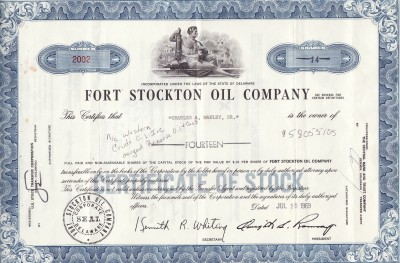People seeking obscure financial information probably will not find riches here – see Not a Millionaire from Old Oil Stock. The American Oil & Gas Historical Society, which depends on your donations, doesn’t have resources for extensive research.
But as AOGHS looks into forum queries as part of its energy education mission, investigations have revealed interesting stories like Mrs. Dysart’s Uranium Well and Buffalo Bill’s Shoshone Oil Company; others have found questionable dealings during booms and “black gold” fever epidemics like Arctic Explorer turns Oil Promoter.
Visit the Stock Certificate Q & A Forum and view company updates regularly added to the A-to-Z listing at Is my Old Oil Stock worth Anything? AOGHS will continue to look into forum queries, including these “in progress.”
Fairchild Petroleum
One company named Fairchild Petroleum was incorporated in 1921 capitalized at $120,000 in Paintsville, Kentucky, a few miles from the town of Oil Springs (also known as Medina) and home to the Big Sandy Oil & Refining Company. Although there was substantial interest in Johnson County’s petroleum prospects, there is little trace of Fairchild Petroleum activity in Kentucky.
More information may be available from the Kentucky secretary of state business services. This notwithstanding, in 1922 a Fairchild Petroleum Company drilled the No. 1 Boggs well in Brazoria County, Texas, and also drilled in Liberty County, near Nome. The No. 1 Boggs reportedly produced oil from a depth of 4,550 feet. The Texas Railroad Commission maintains records that may provide further insights.
Farmers Oil & Gas Company
Many companies have used the name Farmers Oil and Gas Company. One located in Cushing, Oklahoma, was reported by the secretary of state to be “delinquent under the corporation tax law” as of June 30, 1911, which indicates a failed venture and lost investment. Bad luck, since Thomas “Dry Hole” Slick brought in the Wheeler No. 1 well about 12 miles east of Cushing in 1912.
Slick, who will be called Oklahoma’s King of the Wildcatters, opened the prolific Drumright-Cushing oilfield. At its peak, this oilfield produced 330,000 barrels of oil a day. Today, Cushing is where world benchmark prices are set for West Texas Intermediate oil. It is the delivery point designated by the New York Mercantile Exchange for crude oil futures traded each day.
Federal Consolidated Oil Company
In the summer of 1921 the Signal Hill Oil Boom launched a series of discoveries that would make California the source of one-quarter of the world’s entire oil output. Nearby, the Federal Consolidated Oil Company used a cable-tool rig to drill at the Huntington Beach oilfield, about two miles inland. By 1922 the well reached a depth exceeding 2,700 feet without finding oil.
On June 19, 1922, California’s corporate commissioner began investigating the “methods and practices of the company” after shareholders “alleged that the company’s agents misrepresented plans for the drilling of a well.” In December 1923 stockholders held a general meeting to assess the situation, and thereafter, Federal Consolidated Oil Company disappears from financial records.
Fifty-Seven Oil Company
The Fifty-Seven Oil Company spudded its only well southwest of Coalinga, California, on New Year’s Eve, 1909. The well apparently was too far from the producing zone, as were 16 other wells drilled by other companies within a half-mile of Fifty-Seven’s dry hole. The company then disappears from California records.
Fort Stockton Oil Company
 Fort Stockton Oil Company experienced a series of name changes, mergers, and acquisitions – which ultimately lead to today’s Chevron:
Fort Stockton Oil Company experienced a series of name changes, mergers, and acquisitions – which ultimately lead to today’s Chevron:
Fort Stockton Oil Company name changed to Western Crude Oil Inc., July 7, 1971
Western Crude Oil Inc., merged into Reserve Oil & Gas Co., April 17, 1973
Reserve Oil & Gas Co. merged into Getty Oil Co., January 1980
Part of Getty Oil Co. merged into Texaco, 1984
Chevron and Texaco merged into ChevronTexaco, 2001
ChevronTexaco name changed to Chevron in May 2005
The shareholders’ relations agent for Chevron may have information about shares of Fort Stockton Oil Company. The agent will need the exact share owner name as it appears on the certificate, certificate number, share amount and date of certificate. All of this is available on the certificate. Additionally, the agent will want an investor ID for the account.
Franklin Oil & Refining Company
In November 1919 a group of Iowa investors joined the Franklin Oil & Refining Company based on the company’s oil-producing properties in Kansas, Oklahoma and Texas, including the prolific Desdemona oilfield. A 1920 prospectus featured maps of the company’s properties and photographs, including its first well, the Franklin Well No. 1 in Erath County, Texas.
The neighboring Eastland County the Desdemona oilfield was a crowded bonanza for some and dry holes for others (also see Spear Oil Company). Although Franklin Oil & Refining reportedly planned to build a refinery in Des Moines, it never did.
The stories of exploration and production companies joining petroleum booms (and avoiding busts) can be found updated in Is my Old Oil Stock worth Anything? The American Oil & Gas Historical Society preserves U.S. petroleum history. Please support this AOGHS.ORG energy education website. For membership information, contact bawells@aoghs.org. © 2020 Bruce A. Wells.

